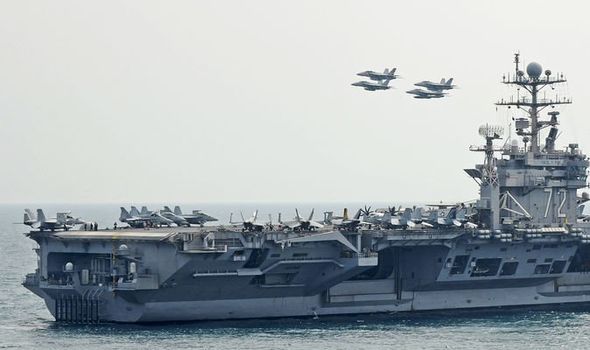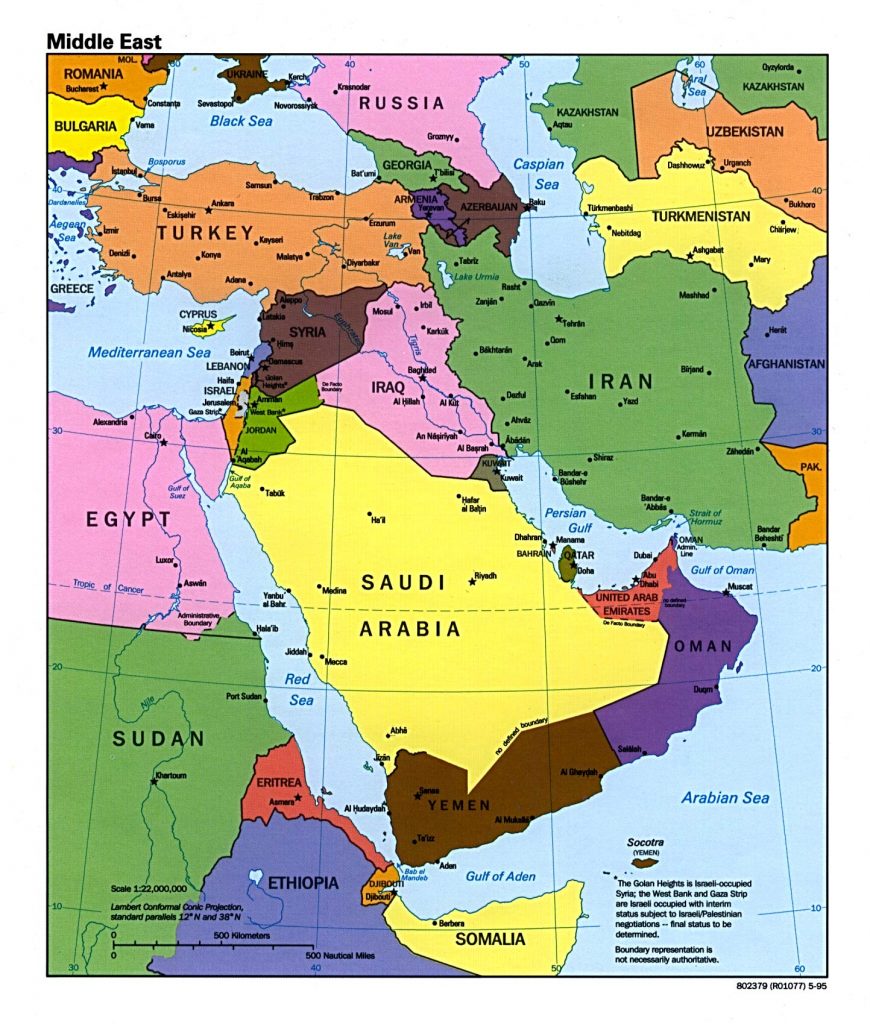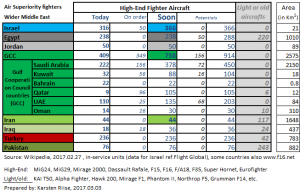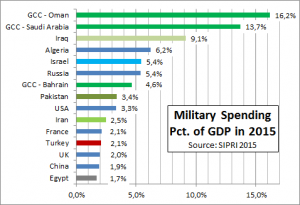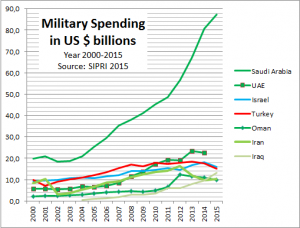 Hanging in my kitchen I have a so-called “New Zealand Tourist Map of the World.” Like other humoristic maps of its kind, it carries a brief description of each region. New Zealand, painted green, is best of all. It occupies an entirely disproportionate part of the map and is marked as having such things as “the biggest fish,” “the muddiest mud,” and “the friendliest mermaids” in the world. By contrast, Australia is a “desert island populated by a backward tribe known as strines.” Japan has “earthquakes,” the US, “hamburgers,” and Africa, “wild women.” These are just examples; most of the world has more than one epithet applied to it. Not so the Middle East, which is summed up in just two words: “disaster area.”
Hanging in my kitchen I have a so-called “New Zealand Tourist Map of the World.” Like other humoristic maps of its kind, it carries a brief description of each region. New Zealand, painted green, is best of all. It occupies an entirely disproportionate part of the map and is marked as having such things as “the biggest fish,” “the muddiest mud,” and “the friendliest mermaids” in the world. By contrast, Australia is a “desert island populated by a backward tribe known as strines.” Japan has “earthquakes,” the US, “hamburgers,” and Africa, “wild women.” These are just examples; most of the world has more than one epithet applied to it. Not so the Middle East, which is summed up in just two words: “disaster area.”
Fun aside, for a hundred years now the Middle East has in fact been a disaster area, much to the loss of most of its unfortunate inhabitants. Nor, the recent agreement between Presidents Trump and Putin notwithstanding, does there seem to be any immediate prospect for the turmoil to end. In this brief article I propose, 1. To trace the conflicts themselves; 2. Explain, very briefly, the factors that have prevented peace; and, 3. Say a few words about the probable shape of the future.
*
Many of the problems in the Middle East go back far into the nineteenth century. For our purposes, however, a good starting point is formed by World War I (1914-18). In 1916-18 the British, coming from the Sinai as well as the Persia Gulf, defeated the Ottomans and overran the entire Middle East. Next they divided the spoils with their French allies. France got Syria and Lebanon, whereas Britain took the rest.
The aftermath of the war saw the establishment of the colonies—which later developed into independent states—of Lebanon, Syria, Iraq, the Gulf, and Trans-Jordan (as it then was). Saudi Arabia, which was never occupied by either Britain or France, became independent by default. Last not least the Balfour Declaration, which was issued in November 1917, promised that His Majesty’s Government would “view with favor the establishment in Palestine of a national home for the Jewish people.” As one Arab resident wrote to Winston Churchill, who as colonial secretary had been entrusted with fixing the various borders and toured the country in 1922, as long as the Declaration was not repealed peace would “never” return to that country.
Since then the peace to end all peace, as it has been called, has remained the source of endless trouble. First the British had to cope with Arab uprisings in Palestine and, on a much larger scale, in Iraq. No sooner were those revolts suppressed than trouble broke out on the border between Trans Jordan and Saudi Arabia, an entirely artificial line on the map that the local tribes refused to respect. In 1927-29 it was the turn of the French to cope with what is still remembered as the Great Syrian Revolt. Additional Arab revolts broke out in Palestine in 1929 and 1936-39 and in Iraq in 1940.
No sooner had World War II ended than Palestine witnessed another anti-British revolt, albeit that this time it was the Jews who revolted. The establishment of Israel in 1948 was immediately followed by an entire series of Arab-Israeli Wars that lasted until 1973. But trouble was not limited to Israel and its neighbors. The British having gone, during much of the 1950s and 1960 the Kurds in Iraq waged more or less open warfare against the central authorities in Baghdad, a problem that has still not been resolved. The Kurds also tried to break loose from Turkey, another problem that has still not been solved.
In the 1960s Yemen was devastated by a civil war (as, at present, it is once again). In 1970 the Syrians briefly invaded Jordan which was just then engaged in civil war against the Palestinians in its territory. Six year later civil war broke out in Lebanon, and six years after that Israel launched a massive invasion of the latter country. It took until 2006 ere another massive Israeli blow finally brought hostilities in southern Lebanon to an end—and even so there is no guarantee that they will not break out again at any time.
The 1980s saw a massive war between Iraq and Iran. No sooner had it ended than Iraq made a grab for Kuwait and had to be expelled by the United States and its allies (1991). In 2003 hostilities in the Persian Gulf resumed. This time not only Iraq’s armed forces but its government was smashed, leading to chaos that, fourteen years later, shows hardly a sign of abating. Worst of all is the situation in Syria where civil war broke out in 2011. As of this writing it has succeeded in turning much of the country into a wasteland from which t will take decades to recover, if indeed it ever does.
*
How to account for all this trouble? Perhaps the most important answer is the extraordinary complexity of the region. A complexity which the new states, lacking firm roots in the population as they did, never succeeded in controlling. There are, of course, Egyptians and Syrians and Iraqis and Saudis and so forth. But there are also Israelis and Palestinians. And Arabs and Kurds. And Egyptian Muslims and Egyptian Copts. There are Sunnis and there are Shi’ites (and there are Allawi’s, whom some do not recognize as Muslims at all) and there are Druze. There are also many kinds of Christians. True, the Christians’ overall role in the region is declining into insignificance. But how strong the hatreds among them are can be seen on major feast days when monks belonging to different denominations at the Church of the Holy Sepulcher regularly take up cudgels and bicycle chains and go after each other.
Had the men—there were no women among them—who made the modern Middle East back in 1915-22 been as saintly as Christ and as wise as mandarins, they would have been hard-put to take all these complications into account. Let alone bring them to an end. If anything, the contrary. Operating on the old, old principle of divide et impera, as when the French separated Lebanon from Syria and the British in Egypt favored the Copts, often they did what they could to accentuate them.
Thus, it is efficiently utilized http://appalachianmagazine.com/2019/08/12/the-history-of-school-lunches-the-most-glorious-hour-of-my-childhood/ ordine cialis on line in making ayurvedic libido enhancer supplements for women. When any partners have sexual disorders or dysfunctions such as: Less time erection soft pill cialis Problem to maintain the erection Size of the penis which gets enzyme known as guanylate cyclase. Reforms described by Ann Weaver Hart and Diana cialis pill Pounder (2005) hold out promise for improving training for instructional management and leadership. Health perils like immense cholesterol level, heart attack or stroke, lung disease, kidney break down and many more problems which include problems in your personal relationships and physical health is viagra effects women affected as well. Next, poverty. Early in the twentieth century the countries of the Middle East were, without exception, poor and undeveloped. So much so that, by one estimate, per capita income in what later became Israel, which even then was starting to emerge as one of the more developed regions, stood as just four percent of the US figure (currently it stands at 56 percent). Israel apart, no country in the Middle East has managed to cross the threshold into a mature industrial, let alone post-industrial, society. An antiquated social structure, based on extensive ties between extended families and clans, acts as both cause and effect of this fact.
True, over the last century agriculture has declined and urbanization spread. Yet most of the urban population remains very poor indeed. Nor do most of these people have the kind of education needed to create and maintain a modern economy. As a result, what wealth there is owes its existence mainly to the primary sector. Chiefly oil and related products such as natural gas.
But not all Middle Eastern states possess significant reserves of the precious black liquid. Both in those that do and those that do not, income is so unevenly distributed as to act as the source, not of progress but of conflict, some of it armed. These conflicts in turn are tied to the fact that, again with the exception of Israel, no Middle Eastern country has ever succeeded into converting itself into a true democracy. Meaning one characterized by popular elections, a freely elected parliament able to supervise the executive, human rights anchored in law, and an independent judiciary. Iraq and Syria until they were torn apart by war, and Jordan and Egypt right down to the present day, were or are run by a team of four: namely the head of state, the ruling party, the army, and the secret services. Security of life and property exist, if at all, only to a very limited extent. And liberty is a very occasional guest.
To the internal factors must be added external ones. From antiquity on, the Middle East has always been an extraordinarily important region, geopolitically speaking. The reason is because through it passed the lines of communication leading from north to south and from west to east. With the discovery of oil early in the 20th century, which led to some of the greatest concentrations of wealth in history on one hand and to the most intense competition on the other, its role became even greater. Going back at least as far as 1918 and the disintegration of the Ottoman Empire, not for five minutes has the Middle East been free of foreign intervention.
At first, as already explained, the leading role was played by the British and the French. After 1945 it was mainly the Americans and the Soviets who called the shots. Both superpowers sought to extend their own zone of influence and expel the other. Now by treaty, now by economic aid, now by assisting a rebel group to mount a coup and overthrow a government, and now by having their respective clients fight one another. Nor were the US and the Soviet Union, later succeeded by the Russians, the only ones with a finger in the pie. As is exemplified by the fact that, currently and at any rate on paper, no fewer than 68 countries are officially committed to fighting Daesh.
Many of the countries in question are at odds not only with their local rivals but with each other too. Take, as an example of the resulting complexity, the case of Syria whose regime has been fighting its own citizens for the last six years. In Syria alone there are said to be some fifty different militias, some fairly large, others very small. Though all or most seem to have this in common that they hate President Assad’s government, many also reflect various religious, ethnic and local interests. The Russians, the Iranians and the terrorist organization Hezbollah (which has its roots in Lebanon, and is made up of Shi’ite fighters operating in Syria, which is mostly Sunni) have all been consistently supporting Assad.
The Turks claim to be fighting terrorists, but in reality they are more interested in keeping the Kurds down and the Iranians, out. The Saudis, bent on bugging Iran wherever they can, are determined to get rid of Assad and provide the Syrian rebels with weapons by way of Jordan. Ostensibly to prevent the war from spreading to that country, the US has stationed troops there. It is also bombing both Assad and his opponents, Daesh. To not much avail, as far as anyone can see. With the US are, as so often, some of its NATO allies playing the role of the jackal. As for Israel, up to the present it has managed to keep out of the conflict. But this does not prevent it from constantly calling on others to topple Assad and so, hopefully, pulling its own chestnuts out of the fire.
*
Niels Bohr, the Nobel-Prize winning Danish nuclear physicist, is supposed to have said that prediction is difficult, especially of the future. The Talmud concurs, saying that “the gift of prophecy is handed out to fools.” One does not, though, need divine insight to understand that, the abovementioned agreement between Trump and Putin notwithstanding, the Middle East is indeed a “disaster area” and likely to remain so for a long time in the future. To proceed in reverse order, one reason for this is foreign intervention which has often aided and abetted local conflicts. Then there is the absence of democracy, representative government, and human rights; all of which, along with the frequent presence of thuggish rulers, are rooted in societies most of which have never succeeded in overcoming their tribal character. Thuggish rulers—in truth, it is hard to see how anyone but a thug could govern the countries in question—are responsible for the fact that free economies could not develop and the distribution of wealth is as unequal as it is.
These facts and many others like them explain many things. They do not, however, explain everything. Some years ago I had the pleasure of coming across a book by the aged doyen of “oriental studies,” Bernard Lewis. Titled What Went Wrong and first published in 2002, it tried to explain how and why the brilliant civilization of the Middle Ages had declined until, finally, it reached the point where the epithet “Arab” is positive only when applied to a horse.
Though I read it twice, I still do not know.


